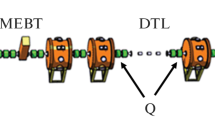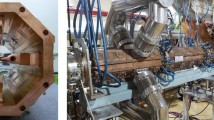Abstract
The China Spallation Neutron Source (CSNS) accelerators consist of an H-linac and a proton Rapid Cycling Synchrotron (RCS). RCS is designed to accumulate and accelerate proton beam from 80 MeV to 1.6 GeV with a repetition rate of 25 Hz. The main dipole and quadruple magnet will operate in AC mode. Due to the adoption of the resonant power supplies, saturation errors of magnetic field cannot be compensated by power supplies. These saturation errors will disturb the linear optics parameters, such as tunes, beta function and dispersion function. The strong space charge effects will cause emittance growth. The compensation of these effects by using trim quadruples is studied, and the corresponding results are presented.
Similar content being viewed by others
References
Wang S, An Y W, Fang S X, et al. An overview of design for CSNS/RCS and beam transport. Sci China Phys Mech Astron, 2011, 54(Suppl. 2): 239–244
Lee S Y. Accelerator Physics. 2nd ed. Singapore: World Scientific, 2004
Gardner C J. Effective placement of stop band correction elements in an AGS lattice. AGS/AD/Tech. Note No. 321, 1989
Shchepunov V A. Betatron tune spread corrections in nuclotron. JINR, P9-92-203, Dubna, 1992
Wang L, Xu H L, Feng G Y, et al. Linear optics compensation of the super conducting wiggler in HLS. In: Proceedings of PAC2005, Knoxville, Tennessee, 2005
Huang X. Beam Diagnosis and Lattice Modeling of the Fermilab Booster. Dissertation for Doctoral Degree. Bloomington: Indiana University, 2005. 174–180
Grote H, Iselin F C. The MAD-Program (Methodical Accelerator Design) Version 8.19 User’s Reference Manual, CERN/SL/90-13 (AP) (Rev. 5), CERN, 1996
Gardner C J, Lee Y Y, Weng W T. Random and systematic field errors in the SNS ring: A study of their effect and compensation. EPAC-98, Stockholm, Sweden, June, 12–26, 1998
Papaphilippou Y, Gardner C J, Lee Y Y, et al. Correction systems upgrade for the SNS ring. In: Proceedings of PAC2003, Chicago, 2003
Mikhailov V A, Shchepunov V A. Magnetic field correction system of nuclotron. In: Proceedings of XIII Russian Conference on Particle Accelerator, II, Dubna, 1992, 253
Delahaye J P, Gelato G, Magnani L, et al. Shaping of proton distribution for raising the space-charge of the CERN ps booster. CERN, Geneva, Switzerland, 1985
Author information
Authors and Affiliations
Corresponding author
Rights and permissions
About this article
Cite this article
An, Y., Wang, S. The compensation of quadrupole errors and space charge effects by using trim quadrupoles. Sci. China Phys. Mech. Astron. 54 (Suppl 2), 214–217 (2011). https://doi.org/10.1007/s11433-011-4566-8
Received:
Accepted:
Published:
Issue Date:
DOI: https://doi.org/10.1007/s11433-011-4566-8




